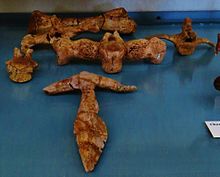| Revision as of 20:15, 3 December 2017 editLythronaxargestes (talk | contribs)Extended confirmed users, Rollbackers12,210 editsm autobox← Previous edit | Revision as of 20:19, 3 December 2017 edit undoLythronaxargestes (talk | contribs)Extended confirmed users, Rollbackers12,210 editsm what kind of stupid amateur taxonomic revision is this?Next edit → | ||
| Line 5: | Line 5: | ||
| | image_width = 250px | | image_width = 250px | ||
| | image_caption = Fossil | | image_caption = Fossil | ||
| |fossil_range = ]- |
|fossil_range = ]-] | ||
| |taxon = Simoedosaurus | |taxon = Simoedosaurus | ||
| |authority = Gervais, 1877 | |authority = Gervais, 1877 | ||
| Line 22: | Line 22: | ||
| ==Biology== | ==Biology== | ||
| ''Simoedosaurus'' was an aquatic predator, specialised to a fully aquatic lifestyle; though '']'' might have still come ashore to lay eggs, ] is known in other choristoderes.<ref>Ji Q., Ji, S., Lü, J., You, H. and Yuan, C. (2006). "Embryos of Early Cretaceous Choristodera (Reptilia) from the Jehol Biota in western Liaoning, China." Journal of the Paleontological Society of Korea, 22(1): 111-118.</ref> It in particular possesses broader, stronger jaws than other longirostrine choristoderes, including its closest relatives, suggesting that it was capable of tackling larger prey |
''Simoedosaurus'' was an aquatic predator, specialised to a fully aquatic lifestyle; though '']'' might have still come ashore to lay eggs, ] is known in other choristoderes.<ref>Ji Q., Ji, S., Lü, J., You, H. and Yuan, C. (2006). "Embryos of Early Cretaceous Choristodera (Reptilia) from the Jehol Biota in western Liaoning, China." Journal of the Paleontological Society of Korea, 22(1): 111-118.</ref> It in particular possesses broader, stronger jaws than other longirostrine choristoderes, including its closest relatives, suggesting that it was capable of tackling larger prey.<ref>Morphology and function of the palatal dentition in Choristodera Article in Journal of Anatomy 228(3):n/a-n/a · November 2015 DOI: 10.1111/joa.12414</ref> | ||
| Article in Journal of Anatomy 228(3):n/a-n/a · November 2015 | |||
| DOI: 10.1111/joa.12414</ref> | |||
| ''Simoedosaurus'' does occur in sites where aquatic ] are present, including brevirostrine forms like '']''; the extent of competition between both groups, if there was any, is still unresolved.<ref>R. Matsumoto and S. E. Evans. 2010. Choristoderes and the freshwater assemblages of Laurasia. Journal of Iberian Geology 36(2):253-274</ref> | ''Simoedosaurus'' does occur in sites where aquatic ] are present, including brevirostrine forms like '']''; the extent of competition between both groups, if there was any, is still unresolved.<ref>R. Matsumoto and S. E. Evans. 2010. Choristoderes and the freshwater assemblages of Laurasia. Journal of Iberian Geology 36(2):253-274</ref> | ||
Revision as of 20:19, 3 December 2017
| Simoedosaurus Temporal range: Paleocene-Eocene | |
|---|---|

| |
| Fossil | |
| Scientific classification | |
| Domain: | Eukaryota |
| Kingdom: | Animalia |
| Phylum: | Chordata |
| Class: | Reptilia |
| Order: | †Choristodera |
| Suborder: | †Neochoristodera |
| Genus: | †Simoedosaurus Gervais, 1877 |
| Type species | |
| Simoedosaurus lemoinei Gervais, 1877 | |
| Other species | |
| |
Simoedosaurus is an extinct reptile known from the Paleocene of North America, Europe and western Asia, and a member of the Choristodera, a group of aquatic reptiles that lived in the Northern Hemisphere from the Jurassic to the early Cenozoic.
Phylogenetics
Though similar to and conspecific, Simoedosaurus is not closely related to the North American Champsosaurus, instead it appears to be most closely related to Tchoiria and Ikechosaurus from the Early Cretaceous of Asia. It therefore may represent a species that immigrated into North America from Asia in the wake of the Cretaceous-Tertiary mass extinction event, though the absence of choristoderes in the Late Cretaceous of Asia makes this merely a paleogeographical speculation.
Biology
Simoedosaurus was an aquatic predator, specialised to a fully aquatic lifestyle; though Champsosaurus might have still come ashore to lay eggs, ovovivipary is known in other choristoderes. It in particular possesses broader, stronger jaws than other longirostrine choristoderes, including its closest relatives, suggesting that it was capable of tackling larger prey.
Simoedosaurus does occur in sites where aquatic crocodilians are present, including brevirostrine forms like Borealosuchus; the extent of competition between both groups, if there was any, is still unresolved.
Range
The earliest records of Simoedosaurus are from the Early Paleocene (Puercan Land Mammal Age) of Saskatchewan. It persisted until the Late Palaecene in North America, and has also been found in the Late Paleocene of France. The youngest remains seem to occur in the Eocene of Kazakhstan.
References
- A. O. Averianov. 2005. The first choristoderes (Diapsida, Choristodera) from the Paleogene of Asia. Palaeontological Journal 39(1):79-84
- R. Matsumoto and S. E. Evans. 2010. Choristoderes and the freshwater assemblages of Laurasia. Journal of Iberian Geology 36(2):253-274
- Ji Q., Ji, S., Lü, J., You, H. and Yuan, C. (2006). "Embryos of Early Cretaceous Choristodera (Reptilia) from the Jehol Biota in western Liaoning, China." Journal of the Paleontological Society of Korea, 22(1): 111-118.
- Morphology and function of the palatal dentition in Choristodera Article in Journal of Anatomy 228(3):n/a-n/a · November 2015 DOI: 10.1111/joa.12414
- R. Matsumoto and S. E. Evans. 2010. Choristoderes and the freshwater assemblages of Laurasia. Journal of Iberian Geology 36(2):253-274
- A. O. Averianov. 2005. The first choristoderes (Diapsida, Choristodera) from the Paleogene of Asia. Palaeontological Journal 39(1):79-84
This article about a prehistoric reptile is a stub. You can help Misplaced Pages by expanding it. |